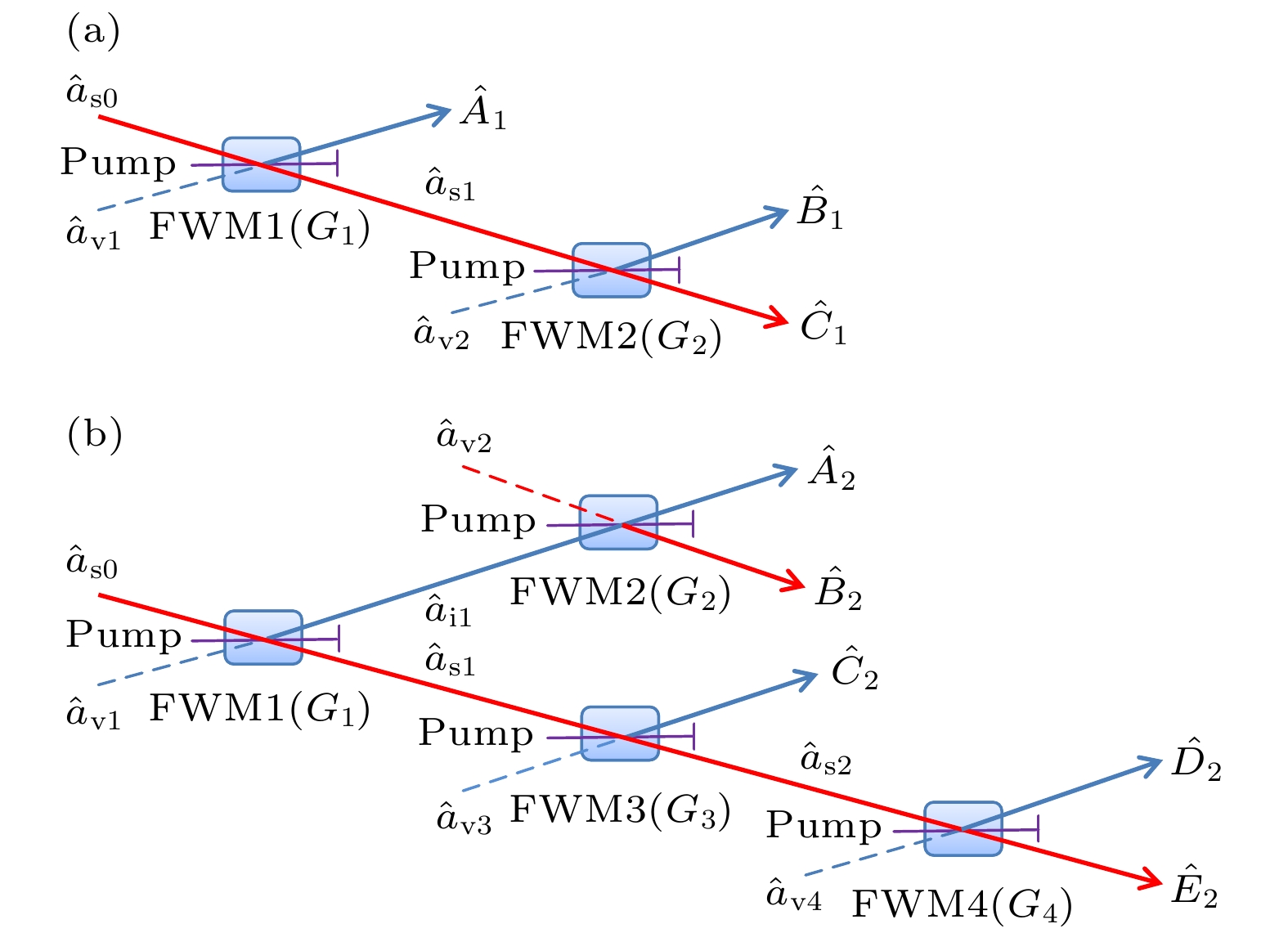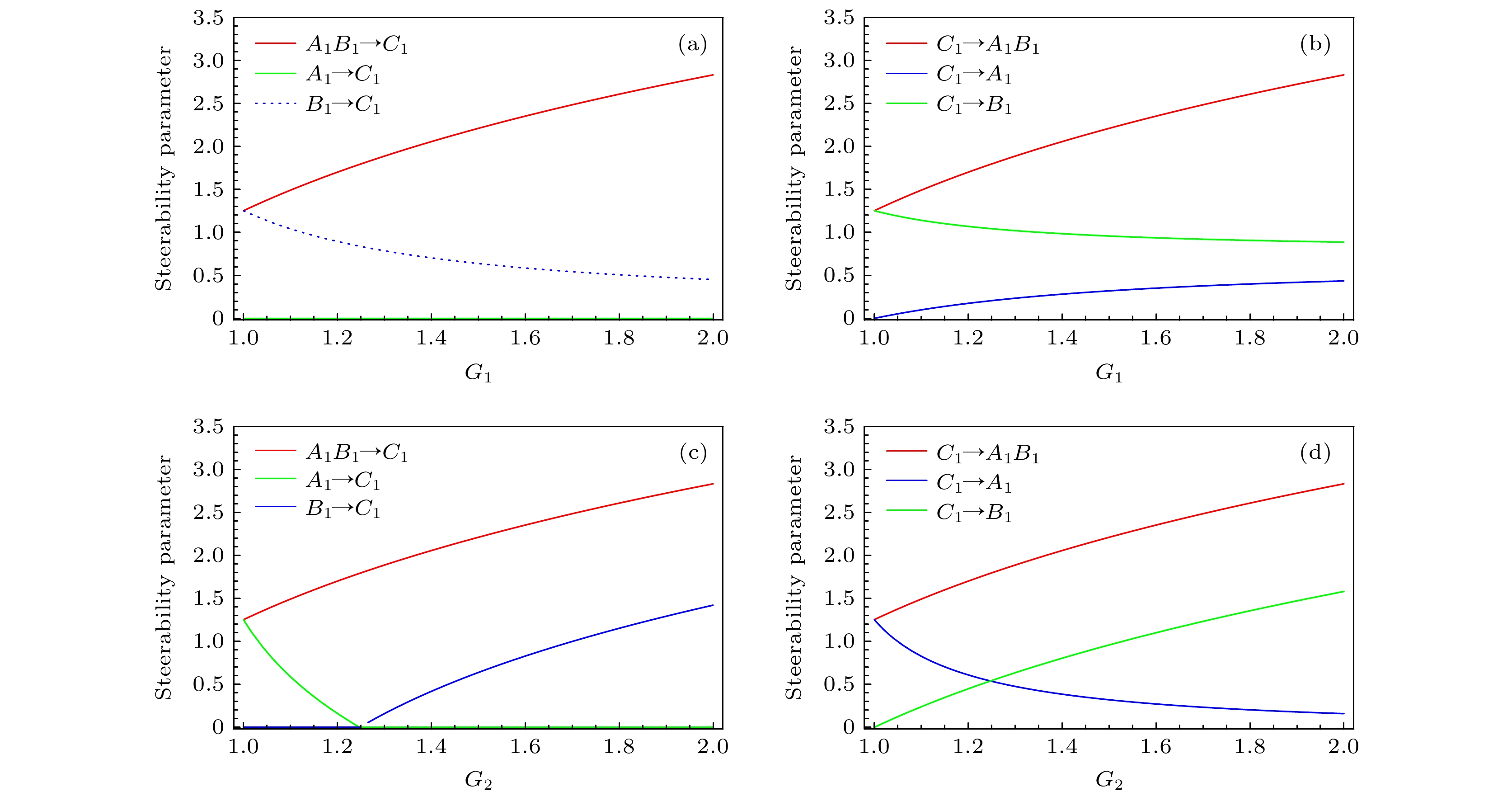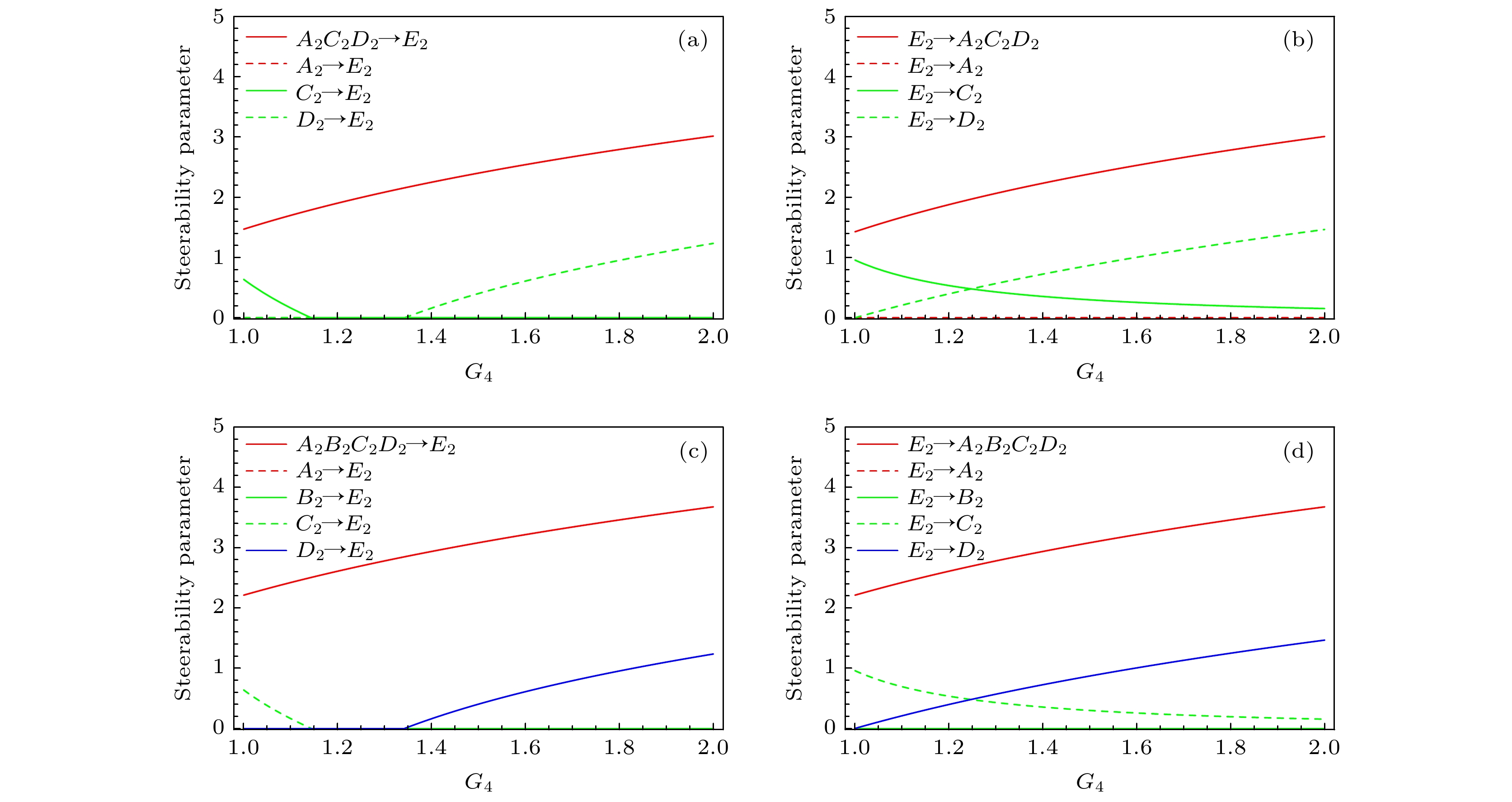-
Multipartite quantum steering is an important quantum resource and the basis of secure quantum communication network. Multipartite quantum steering can be generated by beam splitter networks, optical frequency comb systems and nonlinear processes. Different types of quantum steering will be produced by different projects. In this paper, we design two different schemes, i.e. series cascaded four-wave mixing and hybrid cascaded four-wave mixing, and based on these two schemes tripartite quantum steering and quinquepartite quantum steering are generated respectively. The steering characters among different users are quantified based on the covariance matrix. In theory, we investigate steering parameters among different modes created by two schemes versus the amplitude gain of four-wave mixing process. We find that one mode can steer the other two modes separately, but the other two modes cannot steer the one mode simultaneously. By comparing the steering characters of joint multimodes to a certain single mode with the individual mode to the single mode respectively, it can be seen that the steerability of the former is stronger than the latter in the whole gain region, and there exists only the steering of joint multimodes to a single mode in the partial gain region. More importantly, the steerability of joint multimodes to a single mode can be enhanced with the quantity of joint multimodes increasing. The results show that multiple types of quantum steering can be realized by using these two schemes, which are helpful in understanding the distribution of quantum steering in multipartite system and have important significance in practical secure quantum communication and quantum secret sharing.
[1] Bell J S 1964 Physics 1 195
 Google Scholar
Google Scholar
[2] Horodecki R, Horodecki P, Horodecki M, Horodecki K 2009 Rev. Mod. Phys. 81 865
 Google Scholar
Google Scholar
[3] Jones S J, Wiseman H M, Doherty A C 2007 Phys. Rev. A 76 052116
 Google Scholar
Google Scholar
[4] Cavalcanti E G, Jones S J, Wiseman H M, Reid M D 2009 Phys. Rev. A 80 032112
 Google Scholar
Google Scholar
[5] Cavalcanti D, Skrzypczyk P 2017 Rep. Prog. Phys. 80 024001
 Google Scholar
Google Scholar
[6] Bowles J, Vértesi T, Quintino M T, Brunner N 2014 Phys. Rev. Lett. 112 200402
 Google Scholar
Google Scholar
[7] He Q Y, Gong Q H, Reid M D 2015 Phys. Rev. Lett. 114 060402
 Google Scholar
Google Scholar
[8] Händchen V, Eberle T, Steinlechner S, Samblowski A, Franz T, Werner R F, Schnabel R 2012 Nat. Photonics 6 596
 Google Scholar
Google Scholar
[9] Wollmann S, Walk N, Bennet A J, Wiseman H M, Pryde G J 2016 Phys. Rev. Lett. 116 160403
 Google Scholar
Google Scholar
[10] Sun K, Ye X J, Xu J S, Xu X Y, Tang J S, Wu Y C, Chen J L, Li C F, Guo G C 2016 Phys. Rev. Lett. 116 160404
 Google Scholar
Google Scholar
[11] Branciard C, Cavalcanti E G, Walborn S P, Scarani V, Wiseman H M 2012 Phys. Rev. A 85 010301(R
 Google Scholar
Google Scholar
[12] Walk N, Hosseini S, Geng J, Thearle O, Haw J Y, Armstrong S, Assad S M, Janousek J, Ralph T C, Symulet T, Wiseman H M, Lam P K 2016 Optica 3 634
 Google Scholar
Google Scholar
[13] Kogias I, Xiang Y, He Q Y, Adesso G 2017 Phys. Rev. A 95 012315
 Google Scholar
Google Scholar
[14] Reid M D 2013 Phys. Rev. A 88 062338
 Google Scholar
Google Scholar
[15] He Q Y, Rosales-Zárate L, Adesso G, Reid M D 2015 Phys. Rev. Lett. 115 180502
 Google Scholar
Google Scholar
[16] Chiu C Y, Lambert N, Liao T L, Nori F, Li C M 2016 npj Quantum Inf. 2 16020
 Google Scholar
Google Scholar
[17] Piani M, Watrous J 2015 Phys. Rev. Lett. 114 060404
 Google Scholar
Google Scholar
[18] Uola R, Costa A C S, Nguyen H C, Gühne O 2020 Rev. Mod. Phys. 92 015001
 Google Scholar
Google Scholar
[19] Xiang Y, Kogias I, Adesso G, He Q Y 2017 Phys. Rev. A 95 010101(R
 Google Scholar
Google Scholar
[20] Deng X W, Xiang Y, Tian C X, Adesso G, He Q Y, Gong Q H, Su X L, Xie C D, Peng K C 2017 Phys. Rev. Lett. 118 230501
 Google Scholar
Google Scholar
[21] Armstrong S, Meng W, Teh R Y, Gong Q H, He Q Y, Janousek J, Bachor H A, Reid M D, Ping K L 2015 Nat. Phys. 11 167
 Google Scholar
Google Scholar
[22] Cai Y, Xiang Y, Liu Y, He Q Y, Treps N 2020 Phys. Rev. Res. 2 032046(R)
[23] Qin Z Z, Deng X W, Tian C X, Wang M H, Su X L, Xie C D, Peng K C 2017 Phys. Rev. A 95 052114
 Google Scholar
Google Scholar
[24] 李思瑾 2020 博士学位论文(上海: 华东师范大学)
Li S J 2020 Ph. D. Dissertation (Shanghai: East China Normal University) (in Chinese)
[25] McCormick C F, Boyer V, Arimondo E, Lett P D 2007 Opt. Lett. 32 178
 Google Scholar
Google Scholar
[26] Boyer V, Marino A M, Lett P D 2008 Phys. Rev. Lett. 100 143601
 Google Scholar
Google Scholar
[27] Ding D S, Zhang W, Zhou Z Y, Shi S, Shi B S, Guo G C 2015 Nat. Photonics 9 332
 Google Scholar
Google Scholar
[28] Shu C, Guo X X, Chen P, Loy M M T, Du S W 2015 Phys. Rev. A 91 043820
 Google Scholar
Google Scholar
[29] Wang Y F, Li J F, Zhang S C, Su K Y, Zhou Y R, Liao K Y, Du S W, Yan H, Zhu S L 2019 Nat. Photonics 13 346
 Google Scholar
Google Scholar
[30] Kogias I, Lee A R, Ragy S, Adesso G 2015 Phys. Rev. Lett. 114 060403
 Google Scholar
Google Scholar
[31] Ji S W, Kim M S, Nha H 2015 J. Phys. A 48 135301
 Google Scholar
Google Scholar
[32] Reid M D 2013 Phys. Rev. A 88 062108
 Google Scholar
Google Scholar
-
图 1 (a)串联级联四波混频产生三组份导引示意图.
${\hat a_{{\rm{s0}}}}$ 是信号光注入;${\hat a_{{\rm{v1}}}}$ ,${\hat a_{{\rm{v2}}}}$ 是真空模;${\rm{Pump}}$ 是泵浦光注入.(b)混合级联四波混频产生五组份导引示意图.${\hat a_{{\rm{s0}}}}$ 是信号光注入;${\hat a_{{\rm{v1}}}}$ ,${\hat a_{{\rm{v2}}}}$ ,${\hat a_{{\rm{v3}}}}$ 和${\hat a_{{\rm{v4}}}}$ 是真空模;${\rm{Pump}}$ 是泵浦光注入;${G_i}$ 为相应的四波混频过程的振幅增益Fig. 1. (a) Schematic of generating tripartite steering using series four-wave mixing (FWM)processes.
${\hat a_{{\rm{s0}}}}$ is the seed input;${\hat a_{{\rm{v1}}}}$ and${\hat a_{{\rm{v2}}}}$ are the vacuum modes;${\rm{Pump}}$ is the pump input.(b)Schematic of generating quinquepartite steering using hybrid cascaded FWM processes.${\hat a_{{\rm{s0}}}}$ is the seed input;${\hat a_{{\rm{v1}}}}$ ,${\hat a_{{\rm{v2}}}}$ ,${\hat a_{{\rm{v3}}}}$ and${\hat a_{{\rm{v4}}}}$ are the vacuum modes;${\rm{Pump}}$ is the pump input;${G_i}$ is the amplitude gain of the corresponding FWM processes.图 3 (a)
${G_2} = 1.5$ 时, (2 + 1)型导引参数随${G_1}$ 的变化; (b)${G_2} = 1.5$ 时, (1 + 2)型导引参数随${G_1}$ 的变化; (c)${G_1} = 1.5$ 时, (2 + 1)型导引参数随${G_2}$ 的变化; (d)${G_1} = 1.5$ 时, (1 + 2)型导引参数随${G_2}$ 的变化Fig. 3. (a) The (2 + 1)-type steering parameter versus with
${G_1}$ for fixed${G_2} = 1.5$ ; (b) the (1 + 2)-type steering parameter versus with${G_1}$ for fixed${G_2} = 1.5$ ; (c) the (2 + 1)-type steering parameter versus with${G_2}$ for fixed${G_1} = 1.5$ ; (d) the (1 + 2)-type steering parameter versus with${G_2}$ for fixed${G_1} = 1.5$ .图 4
${G_1} = {G_2} = {G_3} = 1.5$ 时, (2 + 1)型导引参数随${G_4}$ 的变化 (a)$\left( {{C_2}{D_2}} \right)$ 联合导引${E_2}$ 以及${C_2}$ ,${D_2}$ 单独对${E_2}$ 的导引; (b)多种类型两模联合$ \left({A}_{2}{C}_{2}, {A}_{2}{D}_{2}, {B}_{2}{C}_{2}, {B}_{2}{D}_{2}\right)$ 导引${E_2}$ Fig. 4. The (2 + 1)-type steering parameters versus with
${G_4}$ for fixed${G_1} = 1.5$ ,${G_2} = 1.5$ ,${G_3} = 1.5$ : (a)${E_2}$ can be steered by$\left( {{C_2}{D_2}} \right)$ jointly and${E_2}$ can be steered by${C_2}$ ,${D_2}$ individually; (b)${E_2}$ can be steered by different modes combination$ \left({A}_{2}{C}_{2}, {A}_{2}{D}_{2}, {B}_{2}{C}_{2}, {B}_{2}{D}_{2}\right)$ jointly.图 5
${G_1} = {G_2} = {G_3} = 1.5$ 时, (1 + 2)型导引参数随${G_4}$ 的变化 (a)${E_2}$ 对${A_2}$ ,${D_2}$ 的导引以及${E_2}$ 对$\left( {{A_2}{D_2}} \right)$ 联合的导引; (b)${E_2}$ 对${A_2}$ ,${B_2}$ 的导引以及${E_2}$ 对$\left( {{A_2}{B_2}} \right)$ 联合的导引Fig. 5. The (1 + 2)-type steering parameters versus with
${G_4}$ for fixed${G_1} = 1.5$ ,${G_2} = 1.5$ ,${G_3} = 1.5$ : (a) The steering from mode${E_2}$ to individual${A_2}$ ,${D_2}$ and the group of them; (b) the steering from mode${E_2}$ to individual${A_2}$ ,${B_2}$ and the group of them.图 6
${G_1} = {G_2} = {G_3} = 1.5$ 时, (3 + 1)型、(1 + 3)型、(4 + 1)型以及(1 + 4)型导引参数随${G_4}$ 的变化关系 (a)$\left( {{A_2}{C_2}{D_2}} \right)$ 联合导引${E_2}$ 以及${A_2}$ ,${C_2}$ ,${D_2}$ 单独对${E_2}$ 的导引; (b)${E_2}$ 对${A_2}$ ,${C_2}$ ,${D_2}$ 的导引以及${E_2}$ 对$\left( {{A_2}{C_2}{D_2}} \right)$ 联合的导引; (c)$\left( {{A_2}{B_2}{C_2}{D_2}} \right)$ 联合导引${E_2}$ 以及${A_2}$ ,${B_2}$ ,${C_2}$ ,${D_2}$ 单独对${E_2}$ 的导引; (d)${E_2}$ 对${A_2}$ ,${B_2}$ ,${C_2}$ ,${D_2}$ 的导引以及${E_2}$ 对$\left( {{A_2}{B_2}{C_2}{D_2}} \right)$ 联合的导引Fig. 6. The (3 + 1)-type、(1 + 3)-type、(4 + 1)-type and(1 + 4)-type steering parameters versus with
${G_4}$ for fixed${G_1} = 1.5$ ,${G_2} = 1.5$ ,${G_3} = 1.5$ : (a)${E_2}$ can be steered by$\left( {{A_2}{C_2}{D_2}} \right)$ jointly and${E_2}$ can be steered by${C_2}$ ,${D_2}$ individually; (b) the steering from mode${E_2}$ to individual${A_2}$ ,${C_2}$ ,${D_2}$ and the group of them; (c)${E_2}$ can be steered by$\left( {{A_2}{B_2}{C_2}{D_2}} \right)$ jointly and${E_2}$ can be steered by${C_2}$ ,${D_2}$ individually; (d) The steering from mode${E_2}$ to individual${A_2}$ ,${B_2}$ ,${C_2}$ ,${D_2}$ and the group of them. -
[1] Bell J S 1964 Physics 1 195
 Google Scholar
Google Scholar
[2] Horodecki R, Horodecki P, Horodecki M, Horodecki K 2009 Rev. Mod. Phys. 81 865
 Google Scholar
Google Scholar
[3] Jones S J, Wiseman H M, Doherty A C 2007 Phys. Rev. A 76 052116
 Google Scholar
Google Scholar
[4] Cavalcanti E G, Jones S J, Wiseman H M, Reid M D 2009 Phys. Rev. A 80 032112
 Google Scholar
Google Scholar
[5] Cavalcanti D, Skrzypczyk P 2017 Rep. Prog. Phys. 80 024001
 Google Scholar
Google Scholar
[6] Bowles J, Vértesi T, Quintino M T, Brunner N 2014 Phys. Rev. Lett. 112 200402
 Google Scholar
Google Scholar
[7] He Q Y, Gong Q H, Reid M D 2015 Phys. Rev. Lett. 114 060402
 Google Scholar
Google Scholar
[8] Händchen V, Eberle T, Steinlechner S, Samblowski A, Franz T, Werner R F, Schnabel R 2012 Nat. Photonics 6 596
 Google Scholar
Google Scholar
[9] Wollmann S, Walk N, Bennet A J, Wiseman H M, Pryde G J 2016 Phys. Rev. Lett. 116 160403
 Google Scholar
Google Scholar
[10] Sun K, Ye X J, Xu J S, Xu X Y, Tang J S, Wu Y C, Chen J L, Li C F, Guo G C 2016 Phys. Rev. Lett. 116 160404
 Google Scholar
Google Scholar
[11] Branciard C, Cavalcanti E G, Walborn S P, Scarani V, Wiseman H M 2012 Phys. Rev. A 85 010301(R
 Google Scholar
Google Scholar
[12] Walk N, Hosseini S, Geng J, Thearle O, Haw J Y, Armstrong S, Assad S M, Janousek J, Ralph T C, Symulet T, Wiseman H M, Lam P K 2016 Optica 3 634
 Google Scholar
Google Scholar
[13] Kogias I, Xiang Y, He Q Y, Adesso G 2017 Phys. Rev. A 95 012315
 Google Scholar
Google Scholar
[14] Reid M D 2013 Phys. Rev. A 88 062338
 Google Scholar
Google Scholar
[15] He Q Y, Rosales-Zárate L, Adesso G, Reid M D 2015 Phys. Rev. Lett. 115 180502
 Google Scholar
Google Scholar
[16] Chiu C Y, Lambert N, Liao T L, Nori F, Li C M 2016 npj Quantum Inf. 2 16020
 Google Scholar
Google Scholar
[17] Piani M, Watrous J 2015 Phys. Rev. Lett. 114 060404
 Google Scholar
Google Scholar
[18] Uola R, Costa A C S, Nguyen H C, Gühne O 2020 Rev. Mod. Phys. 92 015001
 Google Scholar
Google Scholar
[19] Xiang Y, Kogias I, Adesso G, He Q Y 2017 Phys. Rev. A 95 010101(R
 Google Scholar
Google Scholar
[20] Deng X W, Xiang Y, Tian C X, Adesso G, He Q Y, Gong Q H, Su X L, Xie C D, Peng K C 2017 Phys. Rev. Lett. 118 230501
 Google Scholar
Google Scholar
[21] Armstrong S, Meng W, Teh R Y, Gong Q H, He Q Y, Janousek J, Bachor H A, Reid M D, Ping K L 2015 Nat. Phys. 11 167
 Google Scholar
Google Scholar
[22] Cai Y, Xiang Y, Liu Y, He Q Y, Treps N 2020 Phys. Rev. Res. 2 032046(R)
[23] Qin Z Z, Deng X W, Tian C X, Wang M H, Su X L, Xie C D, Peng K C 2017 Phys. Rev. A 95 052114
 Google Scholar
Google Scholar
[24] 李思瑾 2020 博士学位论文(上海: 华东师范大学)
Li S J 2020 Ph. D. Dissertation (Shanghai: East China Normal University) (in Chinese)
[25] McCormick C F, Boyer V, Arimondo E, Lett P D 2007 Opt. Lett. 32 178
 Google Scholar
Google Scholar
[26] Boyer V, Marino A M, Lett P D 2008 Phys. Rev. Lett. 100 143601
 Google Scholar
Google Scholar
[27] Ding D S, Zhang W, Zhou Z Y, Shi S, Shi B S, Guo G C 2015 Nat. Photonics 9 332
 Google Scholar
Google Scholar
[28] Shu C, Guo X X, Chen P, Loy M M T, Du S W 2015 Phys. Rev. A 91 043820
 Google Scholar
Google Scholar
[29] Wang Y F, Li J F, Zhang S C, Su K Y, Zhou Y R, Liao K Y, Du S W, Yan H, Zhu S L 2019 Nat. Photonics 13 346
 Google Scholar
Google Scholar
[30] Kogias I, Lee A R, Ragy S, Adesso G 2015 Phys. Rev. Lett. 114 060403
 Google Scholar
Google Scholar
[31] Ji S W, Kim M S, Nha H 2015 J. Phys. A 48 135301
 Google Scholar
Google Scholar
[32] Reid M D 2013 Phys. Rev. A 88 062108
 Google Scholar
Google Scholar
计量
- 文章访问数: 7795
- PDF下载量: 139
- 被引次数: 0




































 下载:
下载:



































































































































